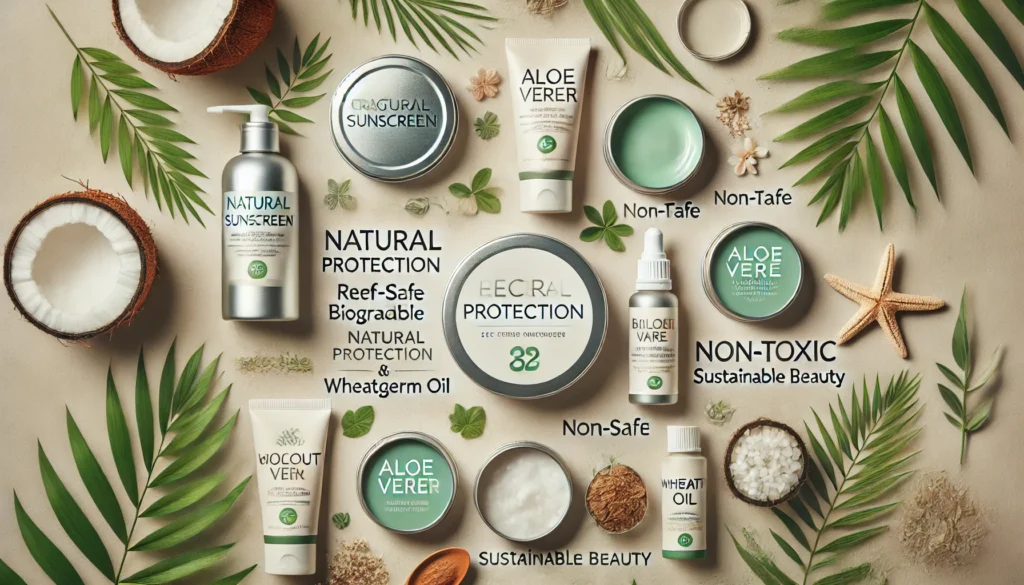Meta Description :Discover the benefits of eco-friendly and reef-safe sunscreen. Learn about mineral vs. chemical options, sustainable ingredients, and how to protect your skin and the environment.
Introduction
Did you know that 14,000 tons of sunscreen are estimated to wash into coral reefs each year, contributing to coral bleaching? While sunscreen protects our skin from harmful UV rays, many conventional options come at a cost to marine life. As awareness of these environmental consequences grows, more people are turning to sustainable, reef-safe alternatives. This blog will guide you toward healthier and eco-conscious sunscreen choices.
The Risks of Conventional Sunscreens
Potential Health Risks
Many commercial sunscreens contain chemicals such as:
- Oxybenzone and Octinoxate: Linked to hormone disruption and skin allergies.
- Parabens: May affect hormone levels.
- Fragrance and Preservatives: Can cause skin irritation, especially in sensitive individuals.
Environmental Impact
Chemical-based sunscreens wash off into the ocean, harming marine life. These chemicals contribute to coral bleaching and disrupt the delicate balance of marine ecosystems. Additionally, certain sunscreens contain microplastics that further pollute the oceans.
Mineral vs. Chemical Sunscreens
Mineral (Physical) Sunscreens
Ingredients: Zinc oxide and titanium dioxide.
Pros:
- Provide broad-spectrum protection by physically blocking UV rays.
- Safer for sensitive skin and less likely to cause irritation.
- Environmentally friendly when formulated with non-nano particles.
Cons:
- May leave a white cast on the skin.
Chemical Sunscreens
Ingredients: Oxybenzone, octinoxate, avobenzone, etc.
Pros:
- Easier to apply without leaving residue.
- Absorb quickly into the skin.
Cons:
- Can irritate sensitive skin.
- Harmful to coral reefs and marine life.
Understanding \”Reef-Safe\” Sunscreens
What Does \”Reef-Safe\” Mean?
Reef-safe sunscreens exclude harmful chemicals that contribute to coral bleaching. Look for products that are free from oxybenzone, octinoxate, and microplastics.
Certifications to Look For
- COSMOS Organic: Ensures organic and natural ingredients.
- Reef Safe Certification: Guarantees protection of marine life.
Sustainable Ingredients and Packaging
Sustainable Ingredients
Look for sunscreens containing:
- Non-nano zinc oxide
- Titanium dioxide
- Aloe vera gel
- Plant-based oils (e.g., coconut, wheatgerm oil)
Eco-Friendly Packaging Options
- Recycled materials
- Metal tins and glass jars
- Biodegradable tubes
Recommendations for Eco-Friendly Sunscreen Brands (Available in India)
Mineral Sunscreens
- Gabit SPF 50 Mineral Sunscreen – Ideal for broad-spectrum protection.
- Mother Sparsh SPF 50 Mineral Sunscreen – Made with safe, natural ingredients.
Aroma Magic Sunscreens
- Aroma Magic SPF 30 Sunscreen for All Skin Types
- Aroma Magic SPF 20 Sunscreen Gel for Oily Skin
- Aroma Magic SPF 30 Sunscreen Lotion for Normal to Sensitive Skin
- Aroma Magic SPF 15 Sunscreen for Normal to Dry Skin
DIY Natural Sunscreen Ingredients
Tips for Sustainable Sunscreen Use
Application Techniques
- Apply generously and reapply every 2 hours.
- Avoid aerosol sprays that contribute to environmental pollution.
Sun-Protective Clothing
Combine sunscreen with protective clothing and seek shade whenever possible.
The Future of Sustainable Sunscreen
As consumers become more environmentally conscious, the demand for sustainable sunscreen options is increasing. Innovations in reef-safe formulations and sustainable packaging are paving the way for a healthier planet and safer skin.
Conclusion
Switching to sustainable, reef-safe sunscreens protects both your skin and the environment. By choosing products with natural ingredients and eco-friendly packaging, you contribute to preserving marine life and coral reefs. Make the switch today and embrace a sunscreen routine that’s good for you and the planet.
Related Blog Posts
- Beyond the Tube: The Eco-Friendly Revolution in Oral Care
- A Scenic Eco-Friendly Travel Destination in India
💬 What’s your go-to eco-friendly sunscreen? Share your favorites in the comments below!


